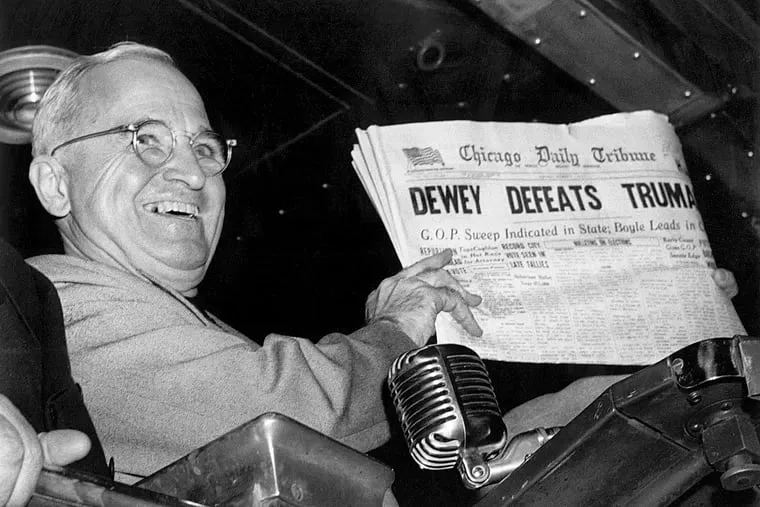
He was an accidental president — a Democratic ex-senator and vice president, thrust into the Oval Office in a chaotic time — and almost every political pundit and journalist insisted he could not win another term. Runaway inflation, especially at the supermarket, had already led to GOP gains in midterms some dubbed “the beefsteak election.” There was a spike in labor unrest at home, and a menacing dictator in Moscow threatened world peace.
American voters were exhausted by years of disruption. There was even an active effort to displace the incumbent president at the top of the ticket, to head off disaster that fall. When that didn’t happen, third-party candidates loomed on the left and the right. The polling numbers for the Democrat were so dismal that one leading firm even stopped doing surveys a month before Election Day.
That proved to be a big mistake, albeit not as famous as the Election Night screw-up by editors at the conservative-minded Chicago Tribune, who produced the big-type erroneous headline, “Dewey Defeats Truman.” Harry Truman — facing a sea of supposedly insurmountable obstacles that would look painfully familiar to today’s President Joe Biden — won that 1948 election over the GOP’s Thomas Dewey by a solid margin.
What’s especially striking about the comparison between a monumental election that just marked its 75th anniversary and today is that the laws of political science haven’t changed as much as you think. The then-novel strategies cooked up by Truman’s kitchen cabinet of advisers — making the vote less about the 33rd president and more about an unpopular Republican brand, with a focus on energizing the Democratic base — look like the best hand Biden can play in 2024.
Whether the Delawarean, who turns 81 later this month, can pull it off may decide the difference between an American 21st century of democracy or dictatorship.
The political world, from TV talking heads to anxious tweeters on Elon Musk’s X, formerly Twitter, has been struggling to make sense of Biden’s chances with just under a year until that do-or-die 2024 vote. Two major data points last week seemed wildly contradictory.
On one hand, Biden’s popularity, and his poll numbers against the all-but-certain GOP nominee — an increasingly dictatorial sounding Donald Trump — are dropping. The much-discussed New York Times/Siena College poll showing the 45th president topping the 46th in five of the six swing states likely to decide the election — matched by other new polls showing Trump pulling ahead — is not destiny, but a loud alarm bell for Democrats to get to work.
Yet last Tuesday, poll-panicked Dems suddenly had something to celebrate. A series of off-year election triumphs in swing states and even red states like Kentucky, where a Democratic governor was reelected, and Ohio, where an abortion-rights amendment won big, showed just how toxic the post-and-pre-Trump GOP brand has become for voters. Many reject the assault on women’s rights and the book-banning culture at the core of Republicanism.
A lot of folks looked at those results and concluded that the Biden polling numbers are bunk. I don’t agree. I think the president has real problems with a) millions of casual, less politically engaged voters who only show up every four years and who think Biden is too old or blame him for chaotic current events and b) core past supporters including under-30 voters or Black and Latino men finding fault with Biden’s record on issues like the war in Gaza.
The specifics aren’t the same, but the incumbent’s bleak scenario would have looked familiar to Truman, who’d seen his approval rating plummet from over 80% in 1945 after FDR’s death thrust him into the Oval Office to just 35% in the pre-election year of 1947, in part because of post-war consumer inflation that peaked at a 20% annual rate.
The Harry Truman analogy is a bit ironic because for much of Biden’s nearly three years in the White House, the nattering nabobs of political history have instead been asking whether the 46th POTUS is channeling the original New Deal Democrat, HST’s predecessor Franklin Roosevelt. Biden’s push for an expanded social-welfare state, major infrastructure work, and stronger labor unions has certainly echoed FDR’s 1930s agenda, albeit with mixed success on Capitol Hill. And a global rise in authoritarianism and militarism that threatened democracy in Europe and elsewhere also looks familiar today.
» READ MORE: Will Biden’s resolute stance on Israel cost him the 2024 election?
But what seems clear now is that the challenges Biden faced coming out of a worldwide pandemic — inflation, a workforce demanding its fair share in a return-to-work economy, an anxious and uneasy electorate — looks more like 1947 than 1933. So how on earth did Truman — with a perception problem not that he was too old for the White House but too small, an accidental president — get reelected? And did he leave lessons for Biden, 75 years later?
Looking back, 1948 was a game-changing election — including the first political conventions beamed into America’s living rooms on TV, as mass media including radio and newspapers played a greater role. Team Truman seemed to understand the new landscape better than the beleaguered Dewey, an overly cautious, boring candidate — famously described by Alice Roosevelt Longworth as “the bridegroom atop a wedding cake” — whose staid campaign was better suited for the turn of the 20th century. Truman’s top political advisers, James Rowe and Clark Clifford — crafted a battle plan called “The Politics of 1948.” Team Biden would do well to read it now.
There are three Truman takeaways that should be invaluable for Biden:
The ‘do-nothing’ Congress. The Truman campaign turned the conventional wisdom — that a presidential election is always a referendum on the incumbent — on its head. Rather than run on his record, the plain-spoken Missourian worked hard to reassemble the winning FDR New Deal coalition with a relentless focus on the Republican Party that had seized control of Capitol Hill in the 1946 midterms. He attacked “the worst Congress” and later “a do-nothing Congress” captured by special interests. And he electrified delegates at 1948′s fractured Democratic National Convention in Philadelphia by calling lawmakers into a special summer session, where Republicans’ refusal to pass popular bills like national health care played right into Truman’s hands.
Today, it’s clear that Biden made an early mistake in hoping that a rebranding of the economy’s strongpoints, including record low unemployment, as “Bidenomics” would move voters more focused on higher prices and soaring rents. Meanwhile, the current House of Representatives — now under Christian nationalist extremist Mike Johnson after months of chaos, struggling to keep the government open — ought to inspire nostalgia for the run-of-the-mill conservatives of Truman’s era. The highly toxic brand of 2023′s Republican Party is what propelled last week’s Democratic wins. Biden — who seems to have wrongly thought Trump would be crushed by his mountain of legal woes — needs to make the do-nothing-or-worse Republicans and the dictatorial danger of Trump his 2024 focus.
Focus on the base. One thing truly groundbreaking about Truman’s “Politics of 1948″ memo was its almost prehistoric emphasis on the need to energize the Democrats’ most loyal core voters rather than the harder task of winning over swing voters. Rowe’s plan for HST aimed to excite big-city African Americans, unionized blue-collar workers and farmers who had been the heart and soul of FDR’s unprecedented four straight election victories. That meant writing off other voting blocs, including the Deep South that had been at the core of Democratic strategy since the Civil War but which in 1948 was going for third-party segregationist Strom Thurmond. Forgetting the South and wooing urban Black voters freed Truman to integrate the armed forces, which helped in key Northern states.
Like Truman, Biden’s challenge in going into 2024 is not to reinvent the wheel — Democrats have won the popular presidential vote in seven of the last eight elections — but to boost enthusiasm and turnout among the coalition that produced those million-vote margins. Today, that includes white voters in cities and suburbs with college degrees, Black and brown voters, and young people of all stripes, among others. Truman outsmarted Dewey by designing campaign trips that intensely targeted the places he needed to win, and Biden must do the same.
‘Give ‘em, hell!’ In the White House, Truman may have shrunk in comparison to the larger-than-life Roosevelt, but crisscrossing America by train in the summer and fall of 1948, his combative style honed in Kansas City’s notorious machine politics suddenly struck a chord with the restive electorate. “We’re going to give ‘em hell,” Truman declared in boarding his whistle-stop express in mid-September. A campaign slogan — and a winning vibe — was born. The growing shouts of “Give ‘em hell, Harry!” from the swelling crowds meant more than any public-opinion poll.
Biden — despite his lifelong struggles with stuttering, and now his advancing age — can be Truman-esque when he is truly unleashed on the campaign trail. “Is there ever anything America set its mind to as a nation that we’ve done together and we haven’t succeeded?” Biden asked union autoworkers celebrating a new contract in Illinois last week, before, uncharacteristically, lashing out at Trump by name. His energized audience booed and someone shouted “send him to jail!” Biden was giving ‘em hell, and his crowd was eating it up.
Times change, but commonalities abound. Voters fret about the economy, but what brings them to the polls is a threat to their fundamental rights. Three-quarters of a century ago, the No. 1 human-rights issue was Jim Crow segregation. Last Tuesday’s election shows that in the 2020s, nothing has motivated voters more than the threat to women’s reproductive rights since the GOP’s handpicked Supreme Court overturned the Roe v. Wade ruling in 2022, as well as the freedom of speech assaults by conservative groups like Moms for Liberty.
Until now, Democrats haven’t fully figured out how to translate that anger into energy into Biden’s reelection, but it can be done. Plans to put abortion-rights referenda on the ballot in key states like Nevada or Florida will help. Team Biden needs to spotlight Trump’s frequent boasts that he’s personally responsible for ending Roe v. Wade through his radical Supreme Court picks.
Abortion rights can be a winning issue. So can voter revulsion at the poisonous GOP brand and growing legitimate fears of dictatorship, which should trump any qualms over Biden’s age. The history of how Biden wins in 2024 was written in 1948. Give ‘em hell, Joe!
» READ MORE: SIGN UP: The Will Bunch Newsletter


